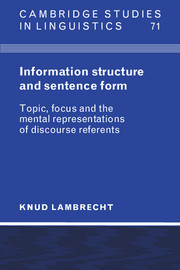Information Structure and Sentence Form
Why do speakers of all languages use different grammatical structures under different communicative circumstances to express the same idea? Professor Lambrecht explores the relationship between the structure of the sentence and the linguistic and extra-linguistic context in which it is used. His analysis is based on the observation that the structure of a sentence reflects a speaker's assumption about the hearer's state of knowledge and consciousness at the time of the utterance. This relationship between speaker assumptions and formal sentence structure is governed by rules and conventions of grammar, in a component called 'information structure'. Four independent but interrelated categories are analysed: presupposition and assertion, identifiability and activation, topic, and focus.
- Major contribution to the study of discourse pragmatics, and its relevance to grammatical analysis and linguistic theory
- Comprehensive theory combining various aspects of information structure usually considered in isolation by other authors
Reviews & endorsements
"It represents the state of the art in functional syntax." Journal of Linguistics
"I recommend that this book be placed in all field libraries, and that consultants in discourse, syntax, and translation be familiar with t." Robert A. Dooley, Notes on Linguistcs
Product details
November 1996Paperback
9780521587044
408 pages
234 × 156 × 27 mm
0.6kg
2 tables
Available
Table of Contents
- Preface
- 1. Introduction
- 2. Information
- 3. The mental representations of discourse referents
- 4. Pragmatic relations: topic
- 5. Pragmatic relations: focus
- 6. Conclusion
- Bibliography
- Index.






